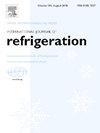Optimization of a novel magnetic refrigerator based on the demagnetizing effect using a particle swarm-like algorithm
IF 3.5
2区 工程技术
Q1 ENGINEERING, MECHANICAL
International Journal of Refrigeration-revue Internationale Du Froid
Pub Date : 2025-01-30
DOI:10.1016/j.ijrefrig.2025.01.016
引用次数: 0
Abstract
The current state of the art of magnetic refrigerator prototyping relies on changes in magnetic field magnitude for promoting heat transfer processes from cold to hot regions. Although this is the most widespread method, some disadvantages arise, such as requiring massive magnets and complex operation mechanisms to alternate the field intensity. Recently, a new operation approach has been proposed using the demagnetizing effect of polycrystalline and anisotropically shaped magnetocaloric materials, which explores the rotation of the magnetic field rather than changes in its magnitude. In this work, we numerically study the performance of a magnetic refrigerator based on this novel approach using a finite element method, considering the half-plate and half-fluid channel model. After performing 92 simulations with random parameters, the no-load temperature span of the system was optimized using a particle swarm-based algorithm to determine the global best. The initial global best from the simulated results was 5.89 K. A new global best of 7.27 K was obtained after applying the algorithm, which represents an increase of over 20%. For the same volume of magnetocaloric material, the temperature span decreases with the inverse aspect ratio. The maximum temperature span of the remaining inverse aspect ratios was successfully determined. In particular, it was possible to increase the temperature span by 22.91% and 18.28% for the inverse aspect ratios 0.26 and 0.4, respectively. This study highlights the feasibility of a novel kind of magnetic refrigerators based on the demagnetizing field.
求助全文
约1分钟内获得全文
求助全文
来源期刊
CiteScore
7.30
自引率
12.80%
发文量
363
审稿时长
3.7 months
期刊介绍:
The International Journal of Refrigeration is published for the International Institute of Refrigeration (IIR) by Elsevier. It is essential reading for all those wishing to keep abreast of research and industrial news in refrigeration, air conditioning and associated fields. This is particularly important in these times of rapid introduction of alternative refrigerants and the emergence of new technology. The journal has published special issues on alternative refrigerants and novel topics in the field of boiling, condensation, heat pumps, food refrigeration, carbon dioxide, ammonia, hydrocarbons, magnetic refrigeration at room temperature, sorptive cooling, phase change materials and slurries, ejector technology, compressors, and solar cooling.
As well as original research papers the International Journal of Refrigeration also includes review articles, papers presented at IIR conferences, short reports and letters describing preliminary results and experimental details, and letters to the Editor on recent areas of discussion and controversy. Other features include forthcoming events, conference reports and book reviews.
Papers are published in either English or French with the IIR news section in both languages.

 求助内容:
求助内容: 应助结果提醒方式:
应助结果提醒方式:


